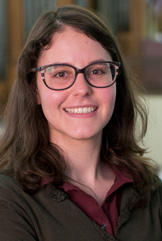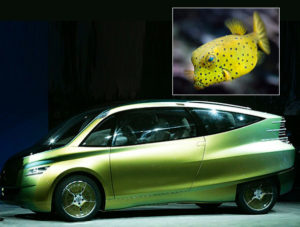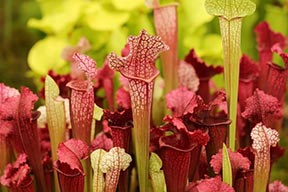Nature is the ultimate innovator, but learning from it requires a new kind of thinking
Nottingham Spirk
Many creatures can change the color of their skin. Octopuses and cuttlefish can change the texture as well, ranking them among nature’s masters of camouflage. That’s why the U.S. Army is funding research into synthetic materials with the same ability, for use on soft, flexible robots, and who knows what else.

This is a terrific example of biomimicry, the practice of seeking solutions in nature. On the surface, it’s elegant in its simplicity. Nature is the ultimate innovator, endlessly launching and tweaking product lines (species) in response to constantly changing markets (habitats). Nature even invented gears. But while humans have been learning from nature since our brains first began to separate us from the other apes, biomimicry as a discipline — or more precisely, cross-disciplinary practice — is in its earliest evolutionary stages. Most biologists aren’t trained to look for commercial applications for their findings, and most designers and engineers aren’t plugged into scientific communities.
Tapping into the vast potential of biomimicry requires new ways of thinking — not just on an as-needed basis but day to day, year to year. That’s where people like Ariana Rupp come in.

A member of our design team since 2015, Rupp is a Fulbright Scholar and biomimicry fellow in the five-year Integrated Bioscience Ph.D. program at the University of Akron. Integrated Bioscience “stretches the boundaries beyond life sciences to include physical sciences, math, and engineering, to name just a few prominent examples.” Fittingly, Rupp is new to biology. Her academic background includes a bachelor’s degree in physics engineering and a master’s in product design.
“The program is open to all sorts of backgrounds,” she explains. “It’s trying to bring a multi-department approach. Even art students are welcome, as long as they are connecting biology to art. It’s about communication and exchanging information from one field to another.”
Learning, then learning more
Broadly speaking, there are two types of biomimicry: problem-driven and solution-based. In a typical problem-driven scenario, engineers look to nature for solutions to specific problems. Like when Mercedes based the design of a concept car on the boxfish, an oddly shaped but quick and maneuverable reef-dweller. Or when a materials scientist asked by the Navy to find a way to reduce algae growth on ships and submarines looked to shark skin for a solution (a discovery that’s now being applied to a wide range of problems).

In solution-based biomimicry, ideas are pushed rather than pulled out of scientific research. Fabric fasteners commonly known by the brand name Velcro are a good example; they were developed by an engineer who wondered why burrs always stuck to his clothes and his dog when they walked in the woods. SLIPS — slippery liquid-infused porous surfaces — could have even more widespread potential. Inspired by the carnivorous pitcher plant and other leaves, SLIPS are being studied for uses are mundane as getting the last bit of ketchup out of the bottle and as important as preventing the buildup of ice on airplane wings and barnacles on ships.
It’s important to understand that in biomimicry, as in all scientific endeavors, data can enlighten and deceive. Pinning down cause and effect can be tricky because organisms’ interactions with their environments can be enormously complex. The Mercedes car prompted some ichthyologists to look more closely at the boxfish, and what they learned upended the science on which the engineers had based their design.

But nature can also be generous with clues. Rupp points to convergent evolution — different organisms coming up independently with the same solution to a problem. For example, North American Cactus and African Euphorbia species have developed remarkably similar methods for dealing with excessive heat, ultraviolet light, and scarce water. “In this case,” she explains, “you have a hint as to what is a very smart design idea.”
Biomimicry as a way of life
Nature can also show us how to improve systems, as Rupp has been demonstrating within Nottingham Spirk.
“We had a multi-department discussion session to double-check the entire NS process,” she explains, “while also checking the Biomimicry 3.8’s Life’s Principles to understand what makes NS thrive. For example, NS successfully leverages interdependence, adjusting processes to different clients. Plus, NS is relatively decentralized and able to self-organize into project teams. These are acknowledged life’s principles.

“Nature’s top strategies for innovation relate to information and structure and conserving energy. A human organization typically will acquire more assets and resources to improve performance. Nature would rather use what is already available and just change how things interact within the network. We then realized how internal feedback loops of information could be further encouraged, creating new forms of documentation and project cataloging for sharing between NS employees.”
Rupp is also guiding NS in bringing biomimetic thinking to our work with clients. It’s a long-term commitment; shortcuts are nothing more than the “window dressing and sales tactics” of “biomimicry-washing.” As Rupp’s colleague at UA, Daphne Fecheyr-Lippens, wrote in her dissertation: “If we want biomimicry to be a feasible design and innovation tool to be commonly used in real-life, time-sensitive challenges, [then] we need people that are trained to be critical connectors, abstractors, and translators over different fields, rather than experts in one field.”
It’s important to get this right. The potential payoffs are much bigger than any one product or company.
“Biomimicry is creating new types of feedback loops of information, and it’s even helping biology itself,” Rupp says. “There’s a new motivation to do biology in a more rigorous and systematic way. It’s really motivating the whole field, and it’s a way to make the biology curriculum more attractive to new students. I would say maybe this is the future of all science. Separations don’t really exist.”
Further reading:
Biomimicry is “Natural” Innovation (Nottingham Spirk)
Biomimicry might be University of Akron's next high-profile field of research (Crain’s Cleveland)
Great Lakes Biomimicry hands reins over to new leaders (Crain’s Cleveland)
About Nottingham Spirk
Nottingham Spirk is a business innovation and product design firm with an unrivaled record of delivering disruptive consumer goods, medical devices, and packaging design solutions to market. We collaborate with Fortune 1,000 companies, funded start-ups and non-profit organizations to discover, design and execute product programs and strategic business platforms that will wow customers, grow markets and generate new revenue streams. Learn more about what makes us different.
Submit a comment